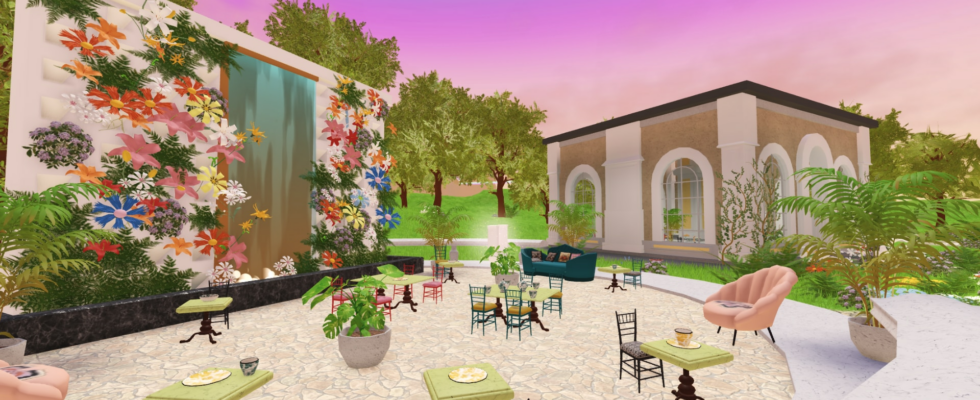Last year’s must-attend Gucci event was held in an even more surprising location than usual: in May 2021, the luxury house opened the Florentine Gucci Garden for two weeks on the popular gaming platform. popular with teenagers called Roblox. She delivered a more than remarkable show, building for the occasion a digital garden in the colors of the brand, NFT collection in support.
Gucci is not the only one to venture off the beaten track to offer the public to live new experiences. Balenciaga wowed fashion critics in 2020 by transporting them to the front row of a show in virtual reality, then in a universe where the supernatural silhouettes of the artistic director, Demna Gvasalia, evolved. For its part, the Hugo label (Hugo Boss) has just created an immersive 360-degree experience with Imaginary Ones, via a collection of NFTs (non-fungible tokenor non-fungible token) exclusive “Embrace Your Emotions” (EYE) featuring 1001 3D animations, including six characters representing emotions.
In search of new generations
If this technological shift in the luxury sector may surprise, it is nevertheless wise: the targets to be conquered are resolutely geek. “The arrival of all these multimillionaires from Silicon Valley and the crypto scene is a game-changer. They don’t have the same expectations, travel less to stores and to major events organized by the big houses”, says Agathe Malinas, partner at Sia Partners. The industry must also make sure to capture the new generations, who will be its future customers. “Ultra-connected millennials will represent more than half of luxury customers by 2025,” said Sébastien Moaligou, director of the luxury division at Fifty-five.
Not easy, however, for these houses steeped in history to find their way in the jungle of emerging technologies. Web3 has monopolized the conversation for the past two years, but the year 2022 was a rather stark reminder that not all projects in this bubbling sector were solid. The proof is: the price of cryptocurrencies has seriously unscrewed in recent months and the sales of NFTs are on a roller coaster. As for the metaverse, whatever Meta (ex-Facebook) suggests by already putting it at the center of all its advertising campaigns, these immersive worlds are in full construction. Virtual reality glasses must become more sophisticated, lighter and see their price drop to become more democratic. The modes of immersion themselves are the subject of debate. If Meta is betting a lot on 100% virtual universes, Apple, for example, seems to be betting more on augmented reality, where digital layers are superimposed on the physical environment without completely obscuring it.
A promising future, conditionally
However, these emerging technologies open up promising prospects for the luxury industry. In the virtual world, imagination becomes the only limit. “Brands offer their customers experiences that they could never offer them in the real world,” observes Thomas Tassin, operations manager at Mira, a company specializing in photorealistic metaverses. The art world has clearly measured the interest of these technologies: the immersive Grand Palais recently created a splendid virtual Venice in which visitors are invited to stroll.
Digital technology is also a powerful tool for animating consumer communities. And for the luxury sector, with rare and expensive creations, this is of interest given the time lapse between two purchases. Classic advertising campaigns are naturally there to remind the good memories of the public. But innovative tools are being watched closely by luxury brands to strengthen and animate their customer relationships, especially NFTs.
According to a study conducted by Bain & Company and the Colbert Committee, 51% of luxury manufacturers are testing the launch of these tokens or planning them in the next three years. NFT is an innovative way to unite communities. “When you own one, you not only own a unique digital object, but you also enter into a community. Because attached to this digital object, there is a whole range of services that only people who hold an NFT from this same collection”, explains Grégory Boutté, director of digital and customer relations at Kering. The lucky holders of these digital passes may, for example, be offered access to private parties or exclusive sales.
Create new experiences
At a time when 40% of the population plays video games, particularly on smartphones, gaming is being watched closely to increase interactions with customers: Louis Vuitton and Burberry have experimented with it. The arrival of virtual fitting tools should also boost online purchases. “It is, for the time being, quite expensive to implement, but these technologies will be democratized”, predicts Diaa Elyaacoubi, CEO of Monnier Paris, a platform specializing in the online sale of luxury accessories.
Of course, these innovations are not all mature yet. It is good, however, that the sector has already begun to explore them because such shifts take time: it is necessary to build the appropriate computer systems, and above all to learn the codes and the language of the target audiences. The luxury industry had belatedly taken the turn of e-commerce, thinking that luxury products were too expensive and singular to be purchased massively on the Internet. Wrongly: 30% of online sales should concern luxury products by 2025. No question, therefore, for the sector to miss this appointment.
So, as they deploy their sales channels on the Web, prestigious brands are transforming their physical sales spaces into immersive spaces. Objective: to invent experiences for these generations fond of novelties. This is evidenced by the rise of spectacular hybrid spaces, where houses build extraordinary places in which showrooms for clothing, hotel suites, restaurants or elegant gardens mingle. Or how borders are blurring.
